Advertisement
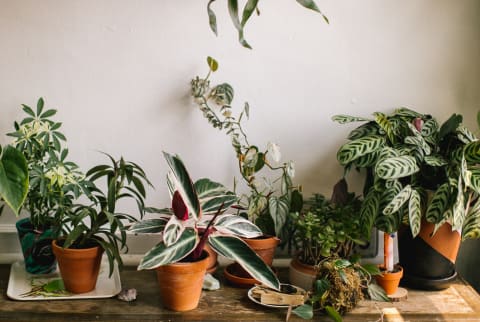
In her new book, Decorating With Plants, floral designer Baylor Chapman shares creative ways to add houseplants to every part of your home. Here are her tips for filling up an underrated room in the plant world: the kitchen!
The kitchen is the heart of the home. It's where people gather, cook, and nourish one another. It's also among the most convenient places to keep plants: With wipeable countertops and sweepable floors, there's a lot less worry about water damage or mess—and, of course, there's always a water source at the ready (simply soak the plants in a filled sink or give them a sprinkle with the faucet). This is a hardworking room, so here are a few plants that can be put to use (including specimens that are good to eat and helpful in controlling pests) and ideas for keeping green things off the countertops and out of the way.
Must-have herbs for the kitchen.
Whether set on your windowsill or hanging from the rafters, herbs are an obvious choice for the kitchen. They look pretty, can be used in cooking, and smell great. Here are just a few of the many herbs that grow well indoors—to start, choose ones you'll enjoy cooking with, so you'll have the satisfaction of using what you grow.
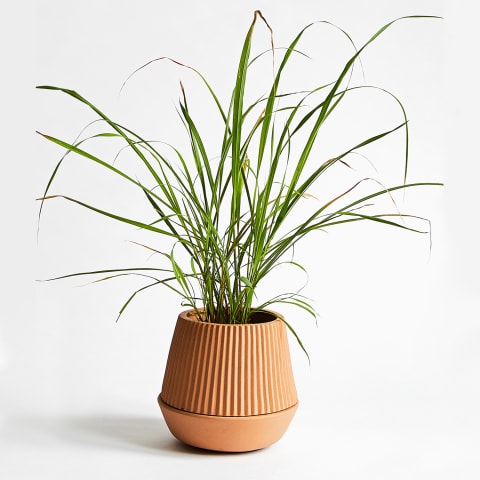
Lemongrass
The tropical fountain of this Asian cooking staple rivals many ornamental grasses in appearance and carries a citrusy fragrance to boot. Use the tender green base of the stem in stir-fries and curries or infuse leaves for tea. With a preference for direct light, lemongrass (Cymbopogon citratus) makes an exotic addition to a sunny windowsill; ensure that the soil remains damp but not soggy.
Harvest regularly to promote new growth, and if you find yourself with more than you know what to do with, dry or freeze it to always have some on hand.
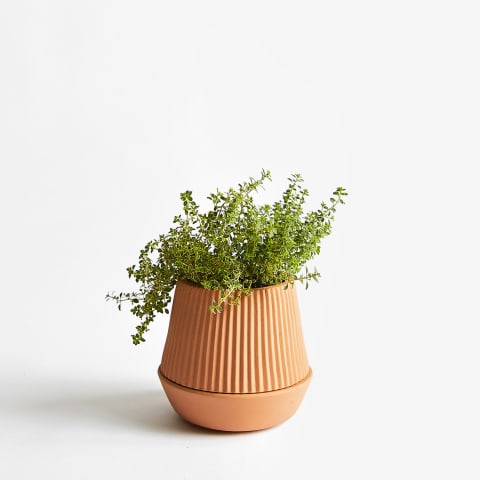
Thyme
Greeks burned thyme as a tribute to their gods, and medieval warriors believed that bathing in it would bestow courage. Pictured here is golden variegated lemon thyme, but there are more than 60 varieties and counting, so choose one that appeals to you. Thyme is a natural partner for vegetable and chicken dishes; it gives a refreshing lift to a pot of tea; and, when crushed, its oils make for a quick and easy homemade mosquito repellent.
Give the plant direct sun or at least six hours of bright light each day, and water when the top inch (2.5 cm) of soil dries out.
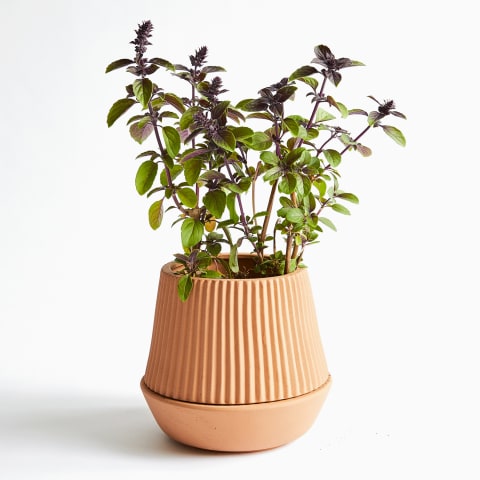
Basil
We all know basil is the perfect partner for juicy tomatoes. The ubiquitous green variety is often found for sale at grocery stores in both bundles and as growing plants. This blue variety—African blue basil (Ocimum kilimandscharicum)—may not be found at your local grocery, but it is worth seeking out for its deep violet blooms and striking stems. It does best in direct light and should be kept away from drafts in winter months. Keep the soil moist but not soggy, and be sure to plant in a pot with a drainage hole.
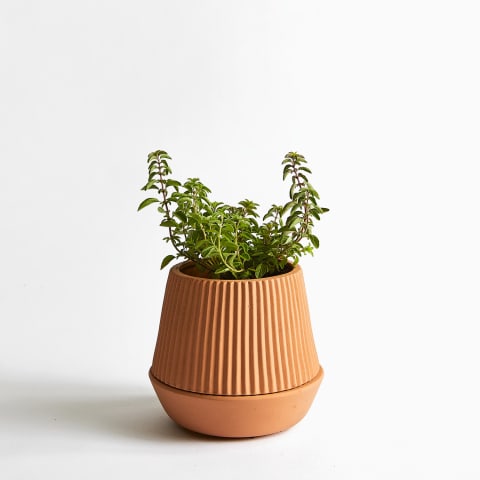
Oregano
The Greeks referred to both oregano (Origanum vulgare) and marjoram (Origanum majorana) as "joy of the mountain." In Greek mythology, Aphrodite created oregano as a symbol of happiness. Its pungent, peppery essence intensifies when it is dried.
For optimal growth, let the direct sun hit the plant and water only when the soil feels dry to the touch.
How to grow and store 'em.
Whether you are starting with just a single plant or are a culinary master who wants a wide range of flavors at your fingertips, here are a few simple ways to grow and store herbs in your kitchen.
Hang
Repurpose an old kitchen standby, the multitiered fruit basket, into your own hanging herb garden. Pair with inexpensive terra-cotta pots, painted in the colors of your choosing as an added upgrade. Grown more for looks than flavor, "Kent Beauty" oregano is the perfect hanging plant, as it offers up pendulous flowers with a profuse fragrance.
Cut
After buying fresh-cut herbs at the market, give the bottoms of the stems a fresh snip, fill a vase with cool water, and place the herbs inside. Remove any leaves that are underwater to help keep the water clear. A multi-mouthed vase allows you to separate each herb into its own slot rather than wrestle with a hodgepodge of greens. Although this storage method is more temporary than keeping a potted plant, cut herbs can stay fresh for a week or more if you change the water often and keep them out of direct sun—and during this time, they will fill your kitchen with their alluring fragrances.
Dry
Give cut herbs a longer life—and add a colorful display to your kitchen wall—by hanging them to dry. Bundle and hang herbs upside down for a few weeks, then store in an airtight container out of direct light and use within a few months (their flavor will gradually fade). If you'd like to keep the herbs on display, I find that oregano, sage, and thyme dry more beautifully than rosemary and basil.
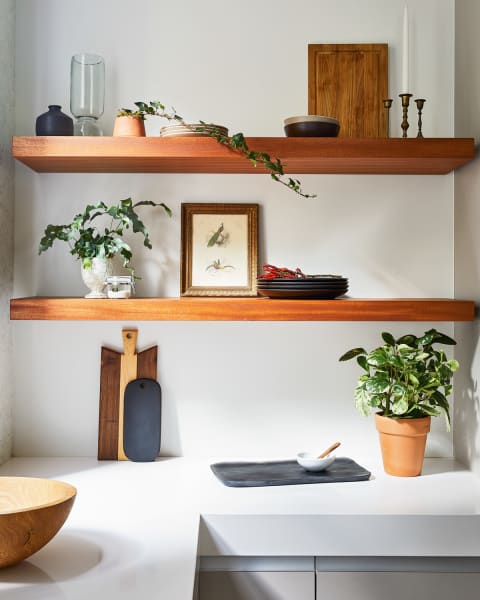
Low light, no problem. These plants can survive in darker conditions.
If your kitchen doesn't get much direct light, fear not! There are still plenty of fabulous plants that can liven up your shelf. Choose a few that are right for you, then brighten up the display by potting them in white and neutral-toned vessels. Avoid overcrowding the shelves—an airy, spare arrangement will help the space feel open and light. Here are a few low-light-friendly plants to consider.
Ivy
Almost any ivy can handle low-light conditions. Some like to crawl and may stick to nearby surfaces. Let some strands dangle to add movement to your shelf. Ivies are generally easy to care for, but they do require some humidity. Solid green varieties like this one are known to grow more easily indoors, but they come in yellow and white variegated leaf patterns as well.
Low-Light Fern
Ferns are thought to have been among the first plants on earth. Their low-maintenance nature and adaptability mean they're still easily found today. Unlike most plants, which reproduce using flowers and seeds, ferns create more ferns via spores on the undersides of their fronds.
Marimo
Native to cool lake bottoms, marimo (Aegagropila linnaei ) prefer low light. For a kitchen-specific twist, plop one in a spice jar turned aquarium! Change the water every few weeks, and give the ball a gentle squeeze periodically to help maintain its round shape.
Baby Rubber Plant
The name baby rubber plant is a misnomer for Peperomia obtusifolia: This member of the peperomia family is not a rubber plant at all and is more closely related to the black pepper plant. It thrives in moderate to bright light but, like all peperomia, is extremely forgiving and will take lower light with ease. Allow the soil to dry between waterings.
Adapted from an excerpt from Decorating With Plants by Baylor Chapman (Artisan Books). Copyright © 2019. Photographs by Aubrie Pick.
